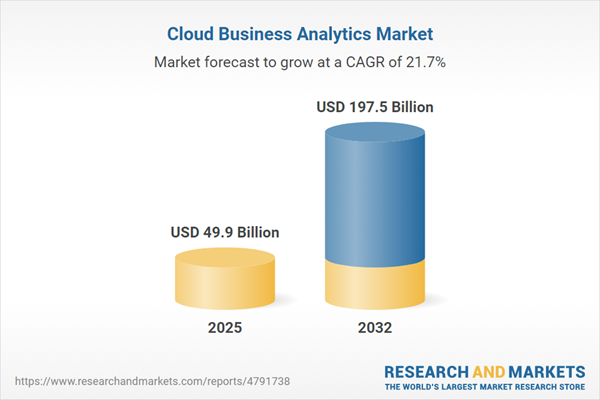Speak directly to the analyst to clarify any post sales queries you may have.
The cloud business analytics market is reinventing how organizations manage digital transformation, providing senior decision-makers with essential tools for business resilience, increased agility, and effective compliance strategies in rapidly changing digital environments.
Cloud Business Analytics Market Snapshot
The global cloud business analytics market is valued at USD 40.98 billion in 2024 and is projected to reach USD 49.90 billion by 2025, with acceleration to USD 197.50 billion by 2032 at a CAGR of 21.72%. Widespread modernization and migration to scalable analytics platforms are driving this growth. Enterprises making the shift to cloud-centric analytics benefit from operational flexibility and adaptability across sectors. Cloud analytics enhance core business processes and deliver timely, data-driven insights that enable compliance, innovation, and competitive positioning during ongoing digital and regulatory shifts.
Scope & Segmentation of the Cloud Business Analytics Market
This report provides executive leadership with a comprehensive guide to the applications, deployment models, and segments defining the cloud business analytics market. Insights into sector-specific adoption reveal how cloud platforms support digital transformation and inform strategic decision-making.
- Deployment Models: Public cloud allows organizations to efficiently adapt to shifting workloads, supporting business continuity initiatives. Private cloud prioritizes privacy and data governance requirements, while hybrid models offer flexibility and meet complex regulatory needs in multinational operations.
- Components: Managed services offer streamlined analytics adoption and reliable technical support, whereas professional services deliver tailored system integration aligned with business objectives. Analytics platforms process and interpret diverse data sets to guide real-time business intelligence.
- Organization Size: Large enterprises employ advanced analytics platforms to monitor and improve operational scale, while small and midsize organizations benefit from accessible, user-friendly solutions for swift insights and targeted business intelligence.
- Industry Verticals: Sectors including banking, insurance, healthcare, life sciences, IT, telecom, manufacturing, retail, and e-commerce utilize analytics to increase process efficiency, mitigate enterprise risk, and engage stakeholders across evolving business landscapes.
- Applications: Key uses include customer analytics, operational intelligence, sales optimization, risk management, and fraud prevention, each empowering data-driven actions for leadership and operations teams.
- Geographies: The Americas are at the forefront of digital progress, EMEA emphasizes governance and compliance, and Asia-Pacific demonstrates rapid adoption to balance regulatory obligations with digital growth.
- Company Analysis: Market leaders such as Microsoft, SAP, Oracle, IBM, SAS Institute, Salesforce, QlikTech, MicroStrategy, Teradata, and TIBCO Software continue to advance analytics capabilities through innovation and strategic industry partnerships.
Key Takeaways for Senior Decision-Makers
- Hybrid and multi-cloud deployments enable dynamic adaptation, allowing organizations to respond to market changes and compliance demands with greater speed and precision.
- Integrating AI-powered automation within analytics platforms equips operational leaders with immediate, actionable insights for effective resource allocation and business outcomes.
- Tailored, industry-focused analytics solutions establish governance frameworks that facilitate risk management and regulatory compliance, especially in sectors with strict oversight.
- Managed services significantly accelerate analytics rollout, optimize cost control, and enhance support for complex, distributed organizational structures.
- Regional disparities in adoption highlight the importance of crafting unique data strategies aligned with distinct regulatory and digital maturity profiles.
- Strategic collaboration among technology partners remains central to scaling analytics programs, modernizing operations, and preparing organizations for shifting business conditions.
Tariff Impact on Cloud Analytics Infrastructure
Recent tariff adjustments in the United States are motivating enterprises to reassess where and how they deploy cloud analytics solutions. Many are turning to hybrid cloud models and local data centers to better manage procurement risks and ensure stronger alignment with changing regulatory requirements. These approaches support continued business operations and bolster the security of corporate analytics infrastructure during regulatory shifts.
Cloud Business Analytics Market Methodology & Data Sources
The research draws on interviews with analytics industry leaders and input from enterprise architects. Additional support comes from leading industry organizations and government data, ensuring the report’s findings are reliable for executive-level decisions.
Why This Report Matters: Cloud Business Analytics Market
- Enables senior executives to benchmark current analytics initiatives against established market metrics and steer critical digital investment decisions.
- Provides clear, structured analysis for navigating digital transformation within complex regulatory and compliance environments.
- Offers actionable recommendations for technology selection, deployment strategies, and vendor partnership models to minimize risk and future-proof analytics infrastructures.
Conclusion
This report equips senior decision-makers with a foundation for advancing organizational digital transformation. Leveraging cloud business analytics in core business strategies accelerates operational agility and prepares companies for resilient, sustainable growth.
Additional Product Information:
- Purchase of this report includes 1 year online access with quarterly updates.
- This report can be updated on request. Please contact our Customer Experience team using the Ask a Question widget on our website.
Table of Contents
3. Executive Summary
4. Market Overview
7. Cumulative Impact of Artificial Intelligence 2025
Companies Mentioned
The companies profiled in this Cloud Business Analytics market report include:- Microsoft Corporation
- SAP SE
- Oracle Corporation
- International Business Machines Corporation
- SAS Institute Inc.
- Salesforce, Inc.
- QlikTech International AB
- MicroStrategy Incorporated
- Teradata Corporation
- TIBCO Software Inc.
Table Information
| Report Attribute | Details |
|---|---|
| No. of Pages | 198 |
| Published | October 2025 |
| Forecast Period | 2025 - 2032 |
| Estimated Market Value ( USD | $ 49.9 Billion |
| Forecasted Market Value ( USD | $ 197.5 Billion |
| Compound Annual Growth Rate | 21.7% |
| Regions Covered | Global |
| No. of Companies Mentioned | 11 |









